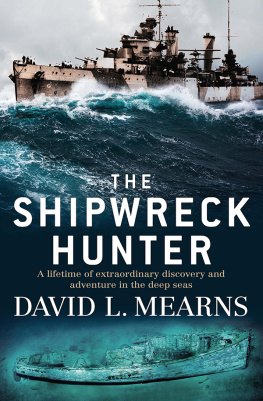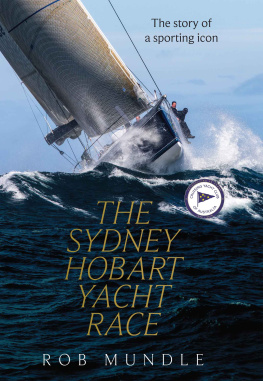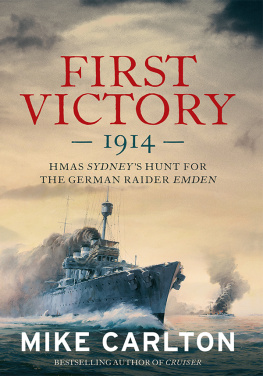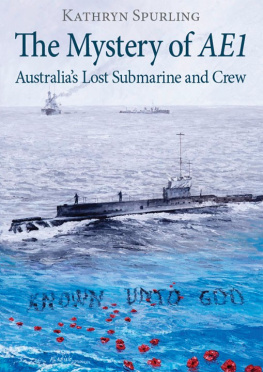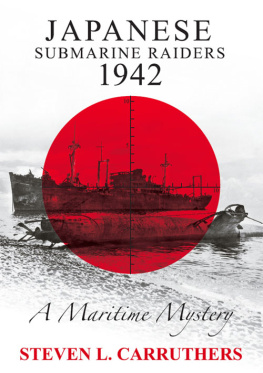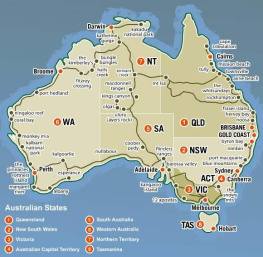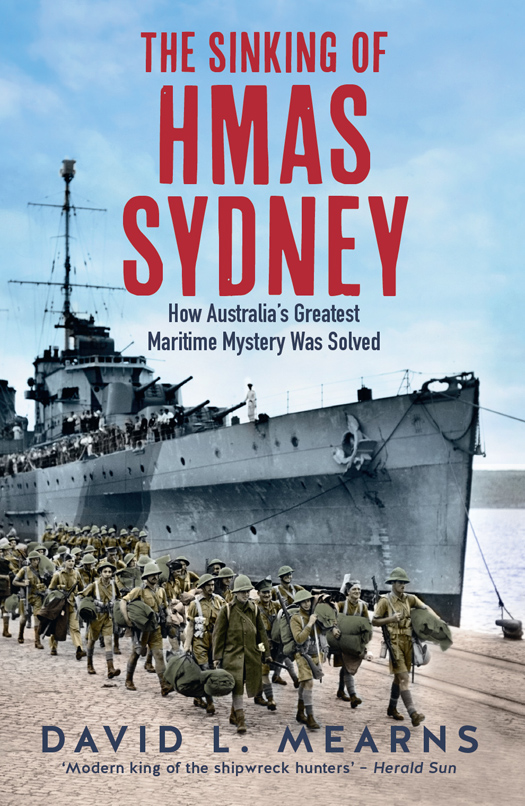Contents
Guide
US-born marine scientist, researcher and deep-sea shipwreck hunter DAVID MEARNS, OAM, has found and filmed some of the worlds most famous and controversial shipwrecks; notoriously difficult wrecks that others predicted would never be found or their mysteries solved. David and his company, Blue Water Recoveries Ltd, have located twenty-four major shipwrecks and have been awarded three Guinness World Records, including one for the deepest shipwreck ever found.
David is a fellow of the Royal Geographical Society and the Explorers Club. In 2010, he was awarded an honorary Medal of the Order of Australia for his work on uncovering the mysteries of both HMAS Sydney and AHS Centaur. David currently lives in Sussex with his wife, Sarah, and their three children.
For Sarah, Sam, Alexandra and Isabella
On 19 November 1941, a fierce battle which was unprecedented
in the annals of naval warfare took place in the Indian Ocean,
far from the coast of Western Australia.This book is dedicated to
the memory of the 645 men from HMAS Sydney and 79 men
from HSK Kormoran who perished as a result.
HarperCollinsPublishers
First published in Australia in 2009
This edition published in 2018
by HarperCollinsPublishers Australia Pty Limited
ABN 36 009 913 517
harpercollins.com.au
Copyright David L. Mearns 2009
The right of David L. Mearns to be identified as the author of this work has been asserted by him in accordance with the Copyright Amendment (Moral Rights) Act 2000.
This work is copyright. Apart from any use as permitted under the Copyright Act 1968, no part may be reproduced, copied, scanned, stored in a retrieval system, recorded, or transmitted, in any form or by any means, without the prior written permission of the publisher.
HarperCollinsPublishers
Level 13, 201 Elizabeth Street, Sydney, NSW 2000, Australia
Unit D1, 63 Apollo Drive, Rosedale, Auckland 0632, New Zealand
A 53, Sector 57, Noida, UP, India
1 London Bridge Street, London SE1 9GF, United Kingdom
2 Bloor Street East, 20th floor, Toronto, Ontario M4W 1A8, Canada
195 Broadway, New York, NY 10007, USA
ISBN 978 14607 5637 9 (pbk)
ISBN 978 14607 1034 0 (epub)
A catalogue record for this book is available from the National Library of Australia
Cover design by Hazel Lam, HarperCollins Design Studio
Cover image IWM (E 1166)
All illustrations courtesy of David Mearns unless otherwise credited
| ASDIC | British anti-submarine detection system that was a precursor of the modern sonar |
| CO | Commanding Officer |
| CWR | Central War Room |
| DCT | Director Control Tower |
| DNI | Director of Naval Intelligence |
| DNOWA | District Naval Officer Western Australia |
| ETA | Estimated Time of Arrival |
| FRUMEL | Fleet Radio Unit Melbourne |
| FSF | Finding Sydney Foundation |
| G | Golf Time GMT plus seven hours (the time kept by Kormoran) |
| GMT | Greenwich Mean Time |
| H | Hotel (Fremantle) Time GMT plus eight hours |
| HACS | High-Angle Control Station |
| HMAS | His/Her Majestys Australian Ship |
| HMA3S | HMAS Sydney Search Pty Ltd |
| HMI | Hydrargyrum Medium-Arc Iodide (lights) |
| HSK | Hilfskreuzer (auxiliary cruiser) |
| HT | Hired Transport |
| Kriegsmarine | German Navy |
| NAA | National Archives of Australia |
| NB | Naval Board |
| POW | Prisoner of War |
| QR | Quadrupal Resonance |
| RAAF | Royal Australian Air Force |
| RACAS | Rear Admiral Commanding the Australian Squadron |
| RAN | Royal Australian Navy |
| RANVR | Royal Australian Navy Volunteer Reserve |
| RN | Royal Navy |
| ROV | Remotely Operated Vehicle |
| SUPSALV | Supervisor of Salvage (US Navy) |
| UNESCO | United Nations Educational, Scientific and Cultural Organisation |
| W/T | Wireless Telegraph |
| WA | West Australian |
| WTB | Watertight Bulkhead |
| Z | Zulu or Z Time (also known as Greenwich Mean Time) |
WHEN HMAS SYDNEY (II) succumbed to battle damage inflicted on her by the German raider Kormoran on the night of 19 November 1941 and disappeared beneath the surface of the Indian Ocean, the short but distinguished career of Australias most famous fighting ship came to an end. The loss of this great warship and her entire complement of 645 officers and men sent a shockwave throughout the Australian nation. It also set in train a series of events that would span two generations before her final resting place was found and her crew laid to rest.
Sydneys loss heralded what was to be the beginning of a particularly dark period for the Royal Australian Navy (RAN) during World War II. In a single afternoon its champion, and all that she represented, was gone, leaving the Australian population feeling vulnerable and exposed to a very uncertain future.
Within a fortnight of Sydneys sinking, the sloop HMAS Parramatta was torpedoed and sunk by a German U-boat in the Mediterranean while escorting a convoy to Tobruk. In March 1942, Sydneys sister ship Perth was sunk following a desperately fought action against an overwhelming force of Imperial Japanese Navy cruisers in the Battle of the Sunda Strait. Within days of Perths loss, the sloop Yarra was sunk when her captain valiantly placed her between the small convoy he was escorting and a superior force of Japanese cruisers and destroyers. By December 1942 the heavy cruiser Canberra, destroyers Vampire, Voyager and Nestor, and corvette Armidale had all joined the RANs rapidly growing list of wartime losses.
The demise of so many ships and men during such a short period left a deep wound in the heart of the Australian nation and came at a time when its naval forces were needed more than ever to protect its own shores and sea lines of communications. Gradually, following a further three years of fighting alongside its Commonwealth and American allies, Australias fortunes changed, and its warships were among those present in Tokyo Bay on 2 September 1945 to bear witness to the formal surrender of the Imperial Japanese Forces, bringing an end to the second great conflict of the twentieth century.
With the cessation of hostilities came renewed hope for a war-weary Australia. Its armed forces were undergoing mass demobilisation and its fighting men and women were returning to the civilian work force, where they looked forward to the future and more prosperous and peaceful times. Thoughts of war were gradually pushed to the back of peoples minds as they strove to put painful memories of armed conflict and lost loved ones behind them. While this was true for the most part, there remained one episode in Australias war at sea which sat uneasily in the consciousness of the Australian people... and that was the loss of Sydney.
By then, four years had passed since her disappearance in 1941, and although numerous other Australian and Allied warships had been lost to enemy action during that time, it was the magnitude of
Next page



